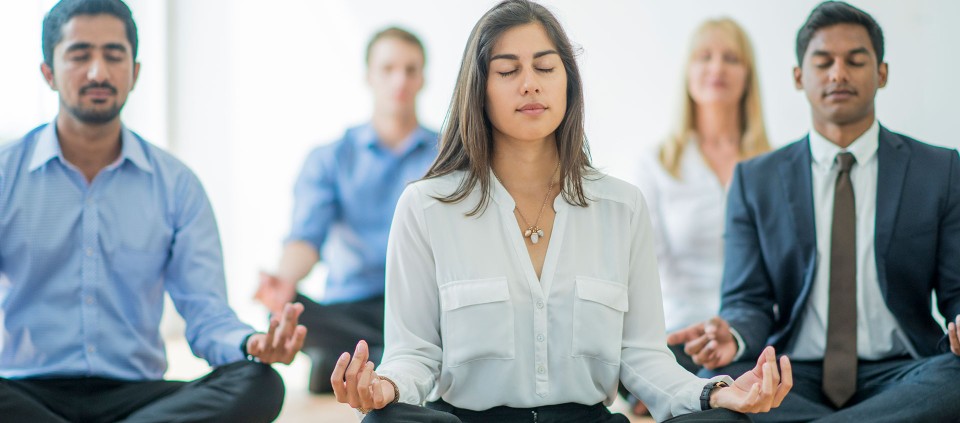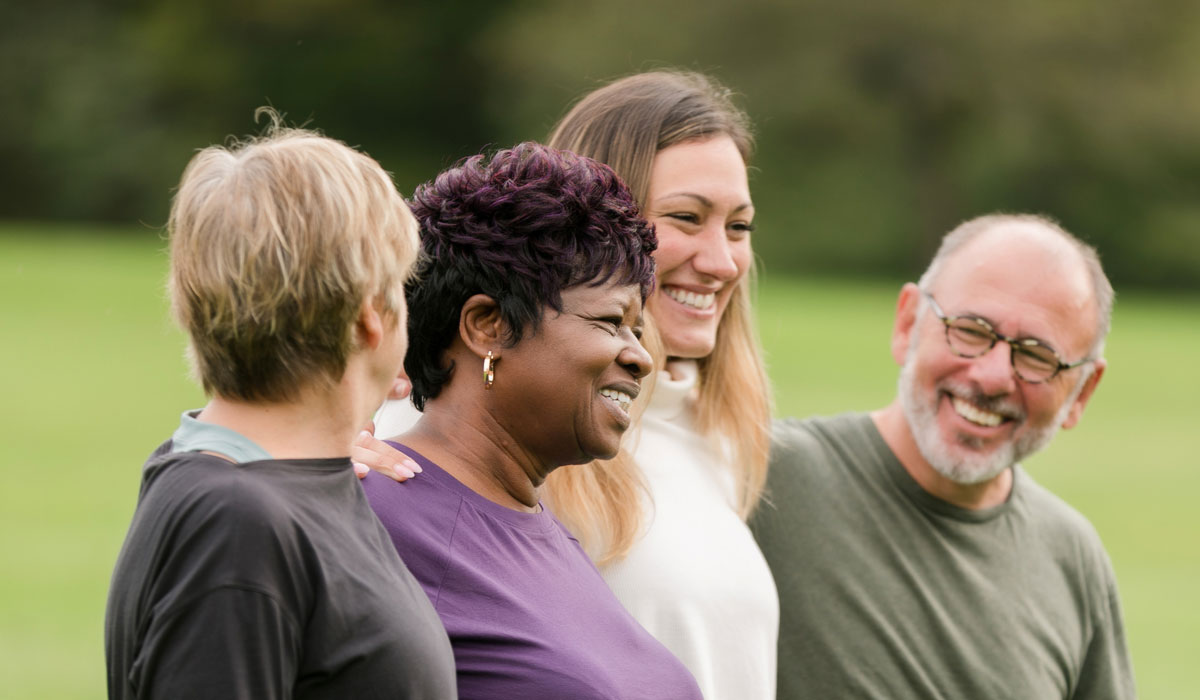We Need to Talk About Stress and Mental Health at Work

In my work, on a daily basis, I have the conversation that everyone wants to have—but no one wants to start. For example—it’s a Friday morning in the boardroom of a Fortune 500 company in lower Manhattan, and I’m leading a Kripalu RISE program on stress resilience. It’s standing room only—people are lining the walls and leaning against the doors. But when I ask, “What are the stresses that brought you in here?,” it’s all crickets.
In our RISE Facilitator training at Kripalu, we learned to wait for eight seconds after asking a question. Eight seconds is longer than a pregnant pause. It gives birth to the kind of silence that grows fast and matures into a thing you can see in the room, just sitting and taking up space.
It’s like this everywhere I go. At the National Guard base, where a soldier tells me, “I don’t have a problem with stress. I eat stress for breakfast,” and then I watch him practically chug a bottle of Pepto at lunch. At the medical school where they’ve hired me to lead yoga and meditation—but matter-of-factly inform me that we can’t hold sessions on the beautiful terrace of their brand-new glass building, which is off-limits to medical students. Why? Because they inadvertently built the balcony railing one foot too low to prevent students from jumping off.
The Conversation That Needs to Happen
We can’t afford to let the seconds keep ticking away on the conversation around stress and mental health in the workplace. A full 80 percent of American workers feel regular stress on the job, and half of them say they need help dealing with it. Furthermore, nearly one in five adults—almost 45 million people—are living with some form of diagnosable mental illness, and most don’t discuss it with their employer.
Yet we want that support more than ever. One survey found that 72 percent of us want a workplace that champions mental health and wellness—which ranked above diversity, equality, and sustainability for every single generation of workers polled. And when the support is there, it pays us all back in spades. For those dealing with mental illness, treatment improves workplace efficacy and satisfaction in more than 80 percent of cases. And it makes good business sense as well: Every dollar spent on scaled treatment returns four dollars in increased productivity and health.
As one of many groups seeking to open up the dialogue on workplace wellness, the RISE program starts by striving to normalize the situation. Most of us spend most our waking hours at work; we want that work to be engaging, and we want to do it in an environment that is encouraging, not debilitating. But when the polish on that ideal fades to a rougher reality, it often leaves us feeling like we just can’t hack it, or like the system is broken. RISE gives individuals and institutions strategies for building resilience, by using the small but significant choices we make throughout the day. Our holistic model addresses how well-being is sustained physically, psychologically, and relationally. We call it the 3 Cs: Calm, Clarity, and Connection.
Embodying Calm
One of the most pernicious stereotypes around stress and mental health is that “it’s all in your head.” But the funny thing about your head is that it’s mostly attached to this other thing called your body. Every single episode of stress, anxiety, or depression is an embodied experience that involves the entire you. Trying to just think your way out of those struggles is fighting with both hands tied behind your back.
In RISE, we always start with techniques and tools that help the body adjust to changing circumstances and breathing practicein an integrated and efficient way. For the individual, this might look like a breathing practice that helps the nervous system more easily ramp down, to prevent overwhelm before a challenging meeting. On an organizational level, this might look like an department instituting a 15-minute buffer between meetings, so that people have adequate time to prepare and process instead of diving headlong and breathlessly from one task to the next. We look for the little things throughout the day that help the body bounce back to baseline and remain ready to serve.
Cultivating Clarity
Your conscious attention is perhaps the most precious natural resource you have access to. Whether you are rich or poor or old or young or happy or sad, your conscious attention can be in only one place at a time. How we care for that precious natural resource will have a huge impact on the quality of our days, and nowadays our attention is under more demand than ever before.
One practice that we utilize extensively in RISE is mindfulness—present-focused, nonjudgmental attention that trains the mind not just to stay with the things we feel are important, but also to meet the moment with an attitude of curiosity and openness. One of the virtues of mindfulness practice is in its adaptability—for the surgeon who does a walking meditation between her office and the operating room, or the high school teacher who begins exam day with a breath meditation, or the police officer who does a body scan when re-entering his patrol car after an incident. Getting a handle on what’s happening inside our own heads is key to doing good and feeling good.
Deepening Connection
The French philosopher Jean-Paul Sartre famously wrote that “Hell is other people,” but it turns out that happiness probably is, too. The quality of our social connection is far and away the most powerful factor in resilience and well-being that we have the ability to change. And when those connections start to fray, it poses a real and often underestimated risk: A 2010 meta-analysis of nearly 150 studies with more than 300,000 people ranked loneliness and social isolation as a risk for mortality equal to smoking and alcoholism.
You read that right: Loneliness could be killing us. And whether or not you side with Sartre when it comes to your workplace, on average it’s the biggest collection of social connections that any of us has access to. Deepening those connections means getting to know people beyond their job descriptions and what they leave in the office fridge for too long. And that includes getting to know ourselves, too. In RISE, we use strengths-based assessments as a tool for digging beneath the “what” we do at work to get at the “why” of our work—those fundamental character aspects of ourselves that we want to express and be seen for. And when we can identify and express our strengths, it turns out that we’re more productive and satisfied at work, as well as happier on and off the job.
One of the most essential things about tools like these is that they’re small but scalable. A couple of deep breaths and a few minutes of meditation aren’t going to radically reshape the landscape of high-stress work. But we’ve found that when individuals and institutions weave interventions promoting calm, clarity, and connection into the rhythms of their day, the difference can be significant and enduring. Our recent research in the Journal of Occupational and Environmental Medicine found that two months after a RISE training, participants averaged 32 percent less perceived stress.
Just imagine what your day might look and feel like with almost a third less stress in it. Go ahead; I’ll gladly wait eight seconds for someone to answer.
Sam Chase, MFA, E-RYT, author of Yoga and the Pursuit of Happiness, holds certificates in yoga and positive psychology from Kripalu and a master’s degree from Harvard.
Full Bio and Programs